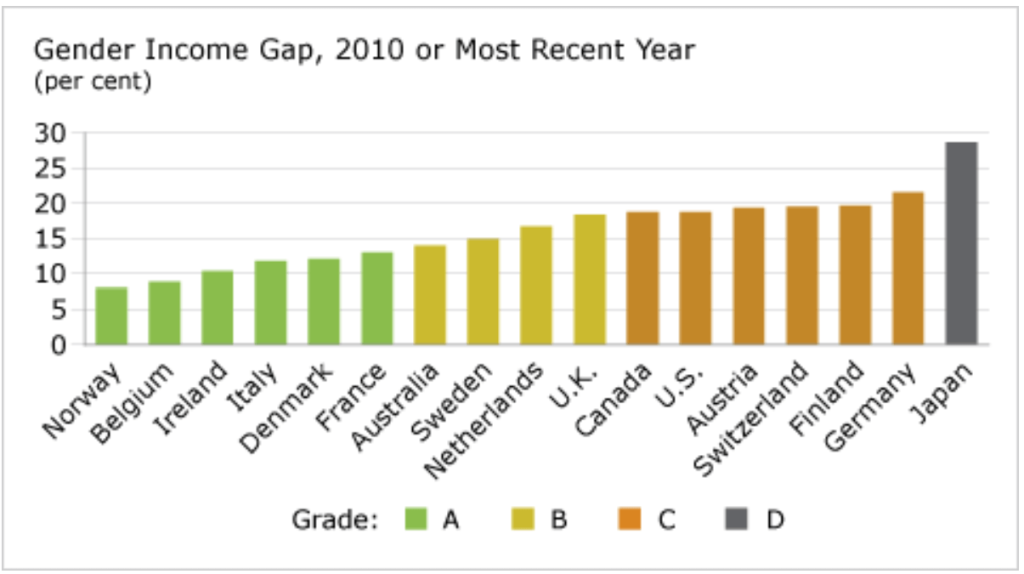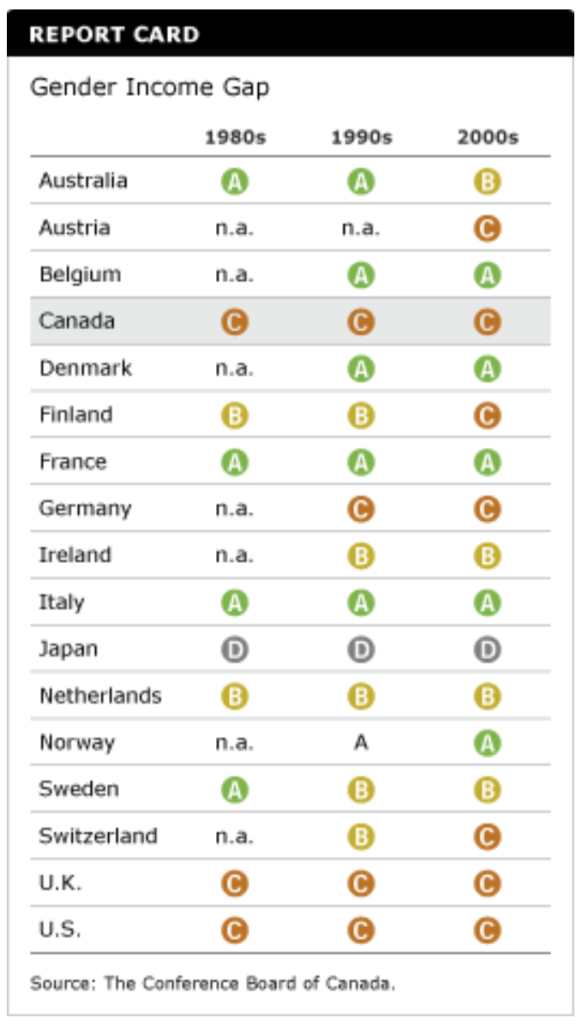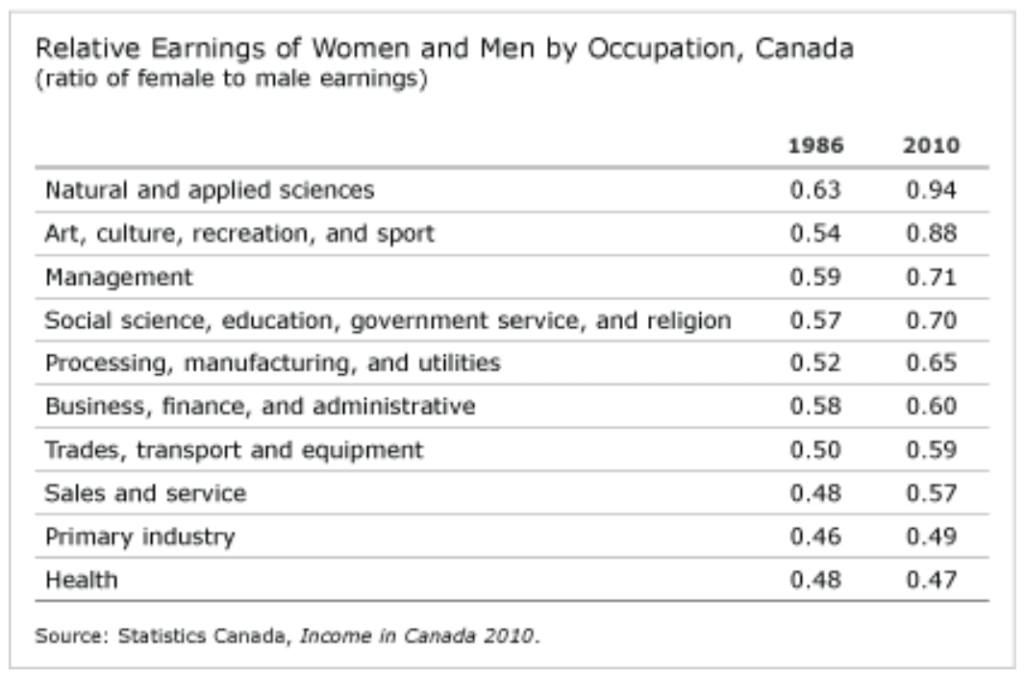Gender Income Gap
Key Messages
- Canada earns a “C” and ranks 11th out of 17 peer countries.
- The gender income gap in Canada persists.
- Age, occupation, and education all affect the size of the gender income gap.

Putting the gender income gap in context
The principle of equality of opportunity is one of the basic tenets of human development. Gender equality is assessed by comparing the ratio of male and female income per capita. The Conference Board research shows that, despite decades of anti-discrimination legislation and equal rights provisions in most peer countries, there is still a significant income gap between men and women in all of the countries ranked here.
Is the Canadian gender income gap greater than that of other countries?
Many Canadians believe that the gender gap has been dealt with. Yet the gap in income between men and women in Canada is 19 per cent. Canada ties with the U.S. for 11th spot and earns a “C” grade. The gender income gap ranges from a low of 8 per cent in Norway to a high of 29 per cent in Japan.
Is the gender income gap closing?
For most peer countries, the gender income gap has narrowed in recent decades. This is likely a reflection of increased educational attainment and training, as well as increased work participation and labour-force attachment.
Between 1990 and the late 2000s, the largest decline in income differences occurred in Ireland, followed by the U.K., Japan, and Germany. Because Japan and Germany had the largest gender income gaps from the outset, they remain in the bottom half of the rankings, despite their improvements.
Despite “A” performances for the past three decades, France and Italy have had a growing gender income gap in the past few years.
Has Canada improved its relative grade?

Canada and most of its peers have managed to narrow the gender gap over the past three decades, thus raising the bar for an “A” performance.
Although Canada’s gender income gap is smaller than it was in the 1980s and 1990s, Canada’s overall grade remained a “C” for the 2000s.
Belgium, Denmark, and Norway earned “A”s in the 1990s and 2000s.1 Japan has been the only country to earn a “D” grade consistently in all three decades. Italy and France have been “A” performers in each decade, although, their standing may be at risk because of their now widening gender gap.
Is the gender income gap affected by such factors as age, occupation, and education?
All of these factors affect the gender income gap.2 Recent data released by Statistics Canada, for example, show that gender pay differences are wider among older workers in Canada. Women aged 25 to 34 earned 78.3 cents for each dollar received by their male counterparts in 2010. Among women aged 45 to 54, the ratio amounted to 75.7 cents.
Gender differences in earnings vary by occupation, with the largest income gap in health occupations, where women earned just 47 cents for every dollar earned by men in 2010. The gender income gap in this occupation has not changed much since 1986. Alternatively, women in natural and applied sciences occupations earned 94 cents for every dollar men earned in those occupations.

These gaps likely reflect differences in educational attainment. Unfortunately, the 2011 census did not gather data on income differences by gender and education. The 2006 census, however, revealed that increased educational attainment among women has traditionally helped to narrow the gender income gap, but it had little impact for younger women. In 1980, 17.8 per cent of Canadian women aged 25 to 29 employed on a full-time, full-year basis held a university degree. Although this proportion almost doubled to 34 per cent in 2000, there has been little change in the earnings ratios for this cohort. Statistics Canada points to rising earnings among young men with no university degree in recent years—due to jobs in the booming oil and constructions industries—as one possible reason for the stagnation in the gender income gap.
Education has been a factor, however, among new entrants into the labour market. In 2005, the gender income gap was narrower for those new entrants that had achieved higher levels of education than for their less-educated counterparts:
- Women aged 25 to 29 holding a graduate or professional diploma and working on a full-time, full-year basis earned 96 cents for every dollar earned by their male counterparts in 2005.
- Women with a bachelor’s degree earned 89 cents for every dollar earned by their male counterparts.
- Women with a registered apprenticeship or trades certificate earned only 65 cents for every dollar earned by their male counterparts.
- Young women with no high school diploma earned 67 cents for every dollar earned by young men with the same level of education.
For the most highly educated Canadian women, gender differences in earnings within identical occupations are generally very small among new entrants to the labour force.
Footnotes
1 Data from the 1980s are not available for Austria, Belgium, Denmark, Germany, Ireland, Norway, and Switzerland.
2 The data and analysis from this section is taken from two sources: Statistics Canada, Income in Canada 2010 (accessed November 1, 2012) and Statistics Canada, Earnings and Incomes of Canadians Over the Past Quarter Century, 2006 Census: Earnings (accessed August 31, 2009).
Society Indicators
See discussions on other indicators

